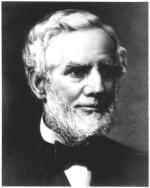Moses Thompson was the last ironmaster of Centre Furnace. He was a banker, an investor in canals, turnpikes and railroads, and at his death in 1891 the largest landowner in Centre County. His economic and political influence helped bring the Farmers’ High School of Pennsylvania, the future Penn State, to Centre County, and he was a leading figure in the school’s early years.
Thompson was born near the Slab Cabin Presbyterian Church and Cemetery, in what is today College Township. He was the son of a militia general, John Thompson, and Elizabeth McFarlane. The Thompsons had moved there from near Milroy, in Mifflin County. They had bought a new farm near the church, which they named “Plum Bottom.” They built a log cabin and then, in 1814, a stone house that still stands along Branch Road. When John Thompson died in 1833, Moses took over the family farm.
On January 4, 1838, Moses Thompson married Mary Irvin, the daughter of John Irvin, an Irish immigrant who was a mason, miller, and store owner in Linden Hall. Mary Irvin was one of twelve children and the sister of a militia general, James Irvin, who would become an ambitious ironmaster, with an ownership stake in nine iron works at various times. James Irvin, an advocate for protective tariffs, served two terms in the U.S. House of Representatives (1841-1845) and ran unsuccessfully as the Whig candidate for governor in 1847.

James Irvin purchased an interest in Centre Furnace in 1828 and invested heavily in Centre County railroads, turnpikes, and the canal connection from Lock Haven to Bellefonte. In 1842, Moses Thompson bought a one-sixth interest in Centre Furnace from his brother-in-law, who had become its sole owner in 1838. Thompson by 1855 had acquired all of Irvin’s Centre Furnace interests. Irvin suffered severe financial reverses in the Panic of 1857, and he died five years later. Thompson soon became the sole owner of all his brother-in-law’s Centre Furnace land, farm, mill, and store operations.
Thompson had survived the Panic in much better shape than many others because he was more heavily invested in farms, than in transportation and industrial activities. Centre Furnace had stopped iron operations in 1858. By this time cheaper iron ore could be shipped by boat from Minnesota, and larger anthracite- and coke-fired iron furnaces were displacing the older, smaller furnaces fueled by charcoal made from declining timber resources. While Thompson continued to purchase farmland after the Civil War, he also invested in more modern ”improvements,” especially turnpikes and railroads.
Along with Irvin, Thompson was an early supporter of the Bald Eagle and Spring Creek Navigation Company, completed in 1846 to move iron down the Susquehanna valley. He became a major stockholder in the Agricultural College and Junction Turnpike and the Boalsburg-to- Bellefonte Turnpike. He later heavily supported the Bald Eagle Valley Railroad and the Lewisburg, Centre, and Spruce Creek Railroads as routes for moving Centre County agricultural products to broader markets.
As the major landowner in Centre County, Thompson was interested in other businesses, and he partnered with Robert McFarland in a local bank, which became Thompson’s Sons. Perhaps his best-known business deal was the sale of more than 500 acres of pine barrens land in present-day Patton Township to Andrew Carnegie, which became the iron plantation of Scotia. The Scotia mines produced low-phosphorous ore for Carnegie Steel from the 1880s into the 1890s. As Carnegie switched to higher-grade Lake Superior ore, a group of investors bought the Scotia property and continued mining and making iron in Bellefonte until shutting down in 1910.
Thompson’s greatest legacy, however, is his Penn State connection. He and Irvin offered Centre Furnace land for the new Farmers’ High School, and he made the largest cash pledge as a donor to the fund for the construction of the College Building (where Old Main now stands). Thompson and his family continued to sell their farmland to expand the college. Today, that land represents more than 4,900 acres of the campus, including the site of Beaver Stadium.
In addition, Thompson and his family contributed service to Penn State. Thompson was secretary of the Board of Trustees from 1859-1864 and treasurer from 1867-1874, as well as a member of the Building Committee. His son, John Irvin Thompson, and son-in-law John Hamilton both also served in roles as treasurer, bookkeeper, and business manager until 1914. All of Thompson’s sons were alumni. John Irvin Thompson of the Class of 1862 was a founding member of the Penn State Alumni Association and served as Henry Varnum Poor’s model for the student to whom Abraham Lincoln hands the tree of knowledge in the central panel of Poor’s Land-Grant Frescoes.
Thompson died on June, 14, 1891, at the age of 81. He is buried in Spring Creek Presbyterian Cemetery. Thompson Hall, a residence hall at Penn State, is named in his honor.
Lee Stout
Sources:
Bezilla, Michael, Penn State: An Illustrated History. University Park: Penn State University Press, 1985.
Linn, John Blaire History of Centre and Clinton Counties. Philadelphia, 1883.
Mairs, Thomas I. Some Pennsylvania Pioneers in Agricultural Science. State College, Pa., 1928.
National Register of Historic Places. Nomination forms for General John Thompson House (College Township, Centre County, PA, 1978); and Lemont Historic District (College Township, Centre County, PA, 1979).
Thompson Family Papers, Centre County Historical Society.
First Published: August 12, 2021
Last Modified: February 24, 2025
